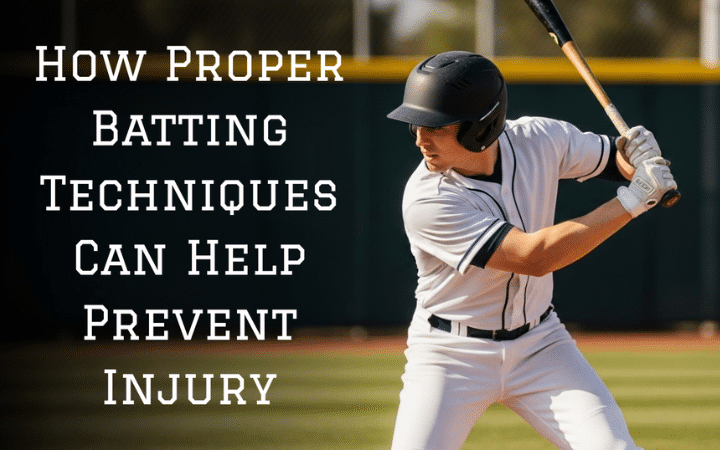
Every player dreams of a long, highlight-filled season. Whether you’re aiming for the fences or consistently hitting those gaps, your ability to stay healthy is paramount. It’s simple: a healthy player is a performing player. Proper batting mechanics aren’t just about boosting your batting average or slugging percentage; they are the bedrock of injury prevention. Small flaws in your swing, repeated over and over, can lead to nagging pains or even serious injuries that can sideline you when your team needs you most.
At The Batter’s Den, we live by ‘With repetition comes results.’ This isn’t just about grooving a powerful swing; it’s about ingraining one that’s both safe and efficient. We’re passionate about developing players holistically, and that means building habits that protect your body while you’re striving to be your best.
Why Your Swing Can Sideline You: Common Batting Injuries & Causes
Ever feel that shoulder ache after a long cage session, or that twinge in your lower back? Often, the root cause lies right in your mechanics at the plate. Here are some common injuries hitters face:
- Wrist Sprains/Tendonitis: Often from “rolling over” the ball too early or an improper grip.
- Oblique Strains: Those powerful core muscles can get overworked or strained with jerky, uncontrolled rotations.
- Lower Back Pain: A classic hitter’s complaint, frequently stemming from poor posture, incorrect weight transfer, or trying to generate all power with the upper body.
- Shoulder Impingement/Rotator Cuff Issues: “Casting” the bat, a long swing, or leading with the elbow can put tremendous stress on this complex joint.
- Elbow Pain (e.g., Tennis/Golfer’s Elbow): Incorrect arm path, too much tension, or “muscling” the bat can contribute.
These injuries often arise from common mechanical flaws:
- Over-swinging: Trying to hit the ball 500 feet on every swing instead of focusing on a smooth, connected motion.
- Poor Weight Transfer: Lunging, or not using your lower half effectively, puts undue stress on your back, knees, and front leg.
- Incorrect Hand/Wrist Action: Forcing the bat through the zone with just your hands and arms.
- Lack of Core Engagement: If your core isn’t firing properly, other, smaller muscle groups have to pick up the slack, leading to strain.
Building an Injury-Proof Swing: Actionable Techniques
Okay, let’s get to the good stuff – the actionable advice you can take straight to the cage! Focusing on these key areas will not only improve your hitting but will make your swing much safer.
The Foundation: Your Stance & Balance
- Proper Technique: Get into an athletic, balanced stance. Your feet should be about shoulder-width apart (or a tad wider if that’s comfortable), with a slight bend in your knees and your weight on the balls of your feet. Maintain a comfortable, upright posture, keeping your head still throughout the swing.
- Injury Prevention Payoff: Think of this as building a strong house – you need a solid foundation! A stable base significantly reduces strain on your lower back and knees. It also prevents you from overreaching or lunging at the ball, which is a quick way to pull a hamstring, groin muscle, or put your shoulder in a vulnerable spot.
Get a Grip: Hand and Bat Position
- Proper Technique: Hold the bat with a relaxed yet firm grip. Many coaches suggest lining up your “door-knocking” knuckles (or using a “box grip”). The bat should be held comfortably, often at a slight angle, ready to attack the hitting zone – not too vertical or too flat.
- Injury Prevention Payoff: Too much tension in your grip radiates right up into your forearms and elbows. A proper, relaxed grip minimizes this, reducing the risk of tendonitis or sprains. It also helps prevent “bat drag” (where the barrel lags too far behind your hands), which can strain your lead shoulder and elbow.
Smooth Power: The Load & Stride
- Proper Technique: Your load should be a smooth, rhythmic shift of weight back, preparing your body to explode forward. Your stride should also be smooth and controlled – not too long, not too rushed – all while maintaining balance and keeping that head still. Avoid over-coiling or twisting too far back.
- Injury Prevention Payoff: A controlled load prevents excessive torque on your spine, which is a big protector for your obliques and lower back muscles. A balanced, moderate stride stops you from over-extending, which can lead to those dreaded hamstring, groin, or hip flexor strains.
The Path to Success (and Safety!): Swing Plane & Connection
- Proper Technique: Focus on keeping your hands “inside the ball.” This means taking a short, direct path with the bat to the point of contact. Maintain a good connection between your arms and your torso, especially as you start your swing – think of your elbows working relatively close to your body.
- Injury Prevention Payoff: This is huge for your shoulders! A compact swing reduces stress on the delicate rotator cuff and labrum, as well as your elbow. “Casting” the bat (letting the barrel get too far away from your body too early) or having a long, loopy swing puts a ton of unnecessary force on these joints.
Unleash the Engine: Hip & Core Rotation
- Proper Technique: Power in your swing should start from the ground up! Initiate your swing sequence with your lower body. Get those hips and your core rotating explosively but in a controlled manner, leading your hands and the bat through the zone.
- Injury Prevention Payoff: Your legs and core contain some of the biggest and strongest muscles in your body. Using them correctly to drive your swing takes a massive amount of stress off the smaller muscles in your arms and shoulders. Proper sequencing also prevents your lower back from trying to do all the rotational work, which can lead to strain and pain.
The Grand Finale: Follow-Through
- Proper Technique: Let your swing finish naturally. A complete and balanced follow-through allows your body to decelerate smoothly without any abrupt stops or jerky movements.
- Injury Prevention Payoff: Think of it like applying brakes smoothly in a car versus slamming them on. A good follow-through helps dissipate the enormous energy generated by your swing correctly, reducing jarring forces on your shoulders, back, and even your lead knee. Cutting your follow-through short can cause muscle tears or joint irritation.
Repetition Breeds Resilience: Practice at The Batter’s Den
Remember our mantra? “With repetition comes results.” This is where the magic happens. Consistently practicing these correct and safe mechanics in our batting cages helps burn them into your muscle memory. They become second nature. The controlled environment here at The Batter’s Den is perfect for you and your coaches to really zone in on these specific mechanical adjustments without the pressure of a live game. It’s your lab for perfecting a swing that’s both powerful and protective.
And don’t forget to seek feedback! Talk to your coaches, watch experienced players, and even film yourself. Understanding what you’re doing right and what needs tweaking is key to developing a sound, safe swing.
Supporting Your Swing: Off-Field Injury Prevention
While technique is king, don’t forget these important supporting actors in the injury prevention show:
- Warm-Up Wisely: Always perform a dynamic warm-up before you start hitting. Get your blood flowing and your muscles ready for action.
- Cool Down & Stretch: After your session, a good cool-down and some static stretching can help with recovery and flexibility.
- Strength & Conditioning: A strong, flexible body is a more resilient body. Focus on exercises that build core strength, leg power, and shoulder stability – all crucial for hitters.
- Listen to Your Body: This might be the most important tip of all. Don’t try to be a hero and play through sharp or persistent pain. Rest and recovery are not signs of weakness; they’re essential for long-term success.
Hit Hard, Hit Smart, Stay in the Game!
Developing proper batting technique is truly a win-win. Not only will you see improvements in your power, contact, and consistency, but you’ll also dramatically reduce your risk of getting hurt. It’s about building a foundation for long-term development and fostering a lifelong passion for baseball or softball.
We urge all you players and coaches out there to prioritize these fundamentals. It’s an investment in your health and your performance.
So, step into our cages here at The Batter’s Den with a clear head, a willingness to learn, and a commitment to working on these techniques. You’ve absolutely got what it takes for success on the field and for a long, healthy playing career. Let us show you how to build a swing that delivers both power and durability. We’re here to help you unlock that potential! Now, let’s get to work!

